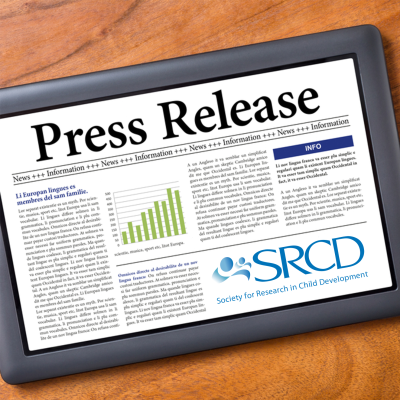Study Shows Both Parents and Peers Play a Role in Greater Alcohol Use Among Adolescents who Experience Early Puberty
PRESS RELEASE / CHILD DEVELOPMENT: Embargoed for Release on April 28, 2021
Research shows that children who experience puberty earlier than their peers are more likely to begin drinking alcohol at a young age and early alcohol exposure is also known to be related to alcohol dependence later in life. Specifically, adolescents who mature early are two to three times more likely to drink than other youth. In addition, early maturing girls are two to three times more likely to drink until intoxication and three times as likely to have an alcohol use disorder. A new study examined why early developing 14-year-old adolescents are more likely to drink alcohol compared to those whose pubertal development is on-time or late. The findings show these adolescents are more likely to have peers who drink alcohol and are also given greater permission to drink by their parents.
The findings were published in a Child Development article, written by researchers at The Pennsylvania State University.
“Peer drinking and parent permissiveness explained a substantial percentage of the links between early puberty and alcohol use,” said Rebecca Bucci, doctoral candidate in the department of sociology and criminology at The Pennsylvania State University. “This is important because early alcohol exposure is known to be related to alcohol dependence later in life.”
The study included intergenerational, nationally representative data from over 11,000 adolescents (5,799 girls and 5,757 boys) in the United Kingdom followed since infancy in the ongoing Millennium Cohort Study (MCS). The current study relied on data collected when the children were aged 9 months, 7, 11, and 14 years. At age 14, adolescents self-reported information about the following:
- Alcohol use: Whether they had ever (in their lifetime) had a drink of alcohol. If yes, they were asked: frequency (3+ times in the prior year denoted frequent drinking given the seriousness of alcohol at age 14) and if they binge drank (consumed 5 or more alcoholic drinks at a time).
- Perceived Pubertal Timing: Girls and boys both reported on personal growth spurts, skin changes, and body hair for boys and girls. Gender-specific questions queried breast development and menstruation for girls and voice changes and facial hair for boys.
- Friend Risk Behavior: To assess risk factors from their peers, adolescents were asked about their friends’ drinking behavior, other-sex friends, and dating from age 11 to 14.
To help assess other childhood risk factors that could contribute to alcohol use, parents and children self-reported information about the following:
- Parental Behavior between the ages of 11 to 14 years: Permissiveness about alcohol use, parental drinking frequency, lack of parental knowledge (how often the parent knew where the child was going, what they were doing, and who they were with), child-parent distance (how close adolescents were to both their mother and father), and unsupervised time.
- Childhood at 9 months and 7 years: Low birth weight was reported on by parents when the children were age 9 months. In addition, parental education and occupational status, single parent household, biological father absence, parental psychological distress, and childhood externalizing, and internalizing behavior problems were measured at age 7.
The findings showed that at age 14, boys and girls who had experienced early puberty were more likely to have consumed alcohol in their lifetime, to drink frequently and to binge drink. They were also more likely to have peers who drank alcohol and parents who permitted them to drink. Later puberty was protective against drinking at age 14. The data showed that only 11% of parents allowed late developing adolescents to drink but 17% of parents of early puberty boys and 22% of parents of early puberty girls allowed them to drink at age 14.
“Children who experience early puberty are no more mature with respect to social or cognitive development than those who experience puberty later, and the potential harms of alcohol are greater at younger ages,” said Jeremy Staff, professor of sociology and criminology at The Pennsylvania State University. “Parents deserve support to continue age-appropriate monitoring throughout adolescence. Looking more like an adult does not mean a teen can drink safely. Being more permissive about alcohol use does not prevent future problems.”
Additionally, the authors suggest that schools and communities should invest in evidence-based universal prevention efforts regarding alcohol use and medical providers and should follow American Academy of Pediatrics guidelines to begin universal screening for alcohol exposure at age 11. Providers can support parents in aiming for alcohol-free childhoods.
Researchers note that the context of the analysis is based in the UK which differs from alcohol and pubertal timing studies conducted in the United States (UK alcohol use among teens is high – around 70% of 16-year-olds reported alcohol consumption in 2007). The authors also acknowledge that other unobserved factors may contribute to the association between early pubertal timing and adolescent drinking including hormonal changes and structural and functional changes to the brain. Future research should parse out further nuances regarding parental alcohol permissiveness, such as whether parents supplied alcohol for parties or only allowed the child to drink in their presence. Future studies could also be strengthened by using clinician (rather than self-report) of pubertal timing and peer reports of their own alcohol use (rather than peer use as perceived by the child who is the focus of the study).
###
This work is supported by the Economic and Social Research Council UK (ESRC) and the United States National Institute on Alcohol Abuse and Alcoholism.
Summarized from Child Development, Pubertal Timing and Adolescent Alcohol Use: The Mediating Role of Parental and Peer Influences by Bucci, R., Staff, J., Maggs, J., and Dorn, L. (The Pennsylvania State University). Copyright 2021 The Society for Research in Child Development, Inc. All rights reserved.


